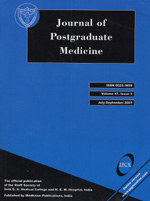
|
Journal of Postgraduate Medicine
Medknow Publications and Staff Society of Seth GS Medical College and KEM Hospital, Mumbai, India
ISSN: 0022-3859
EISSN: 0022-3859
Vol. 54, No. 2, 2008, pp. 126-134
|
 Bioline Code: jp08044
Bioline Code: jp08044
Full paper language: English
Document type: Review Article
Document available free of charge
|
|
|
Journal of Postgraduate Medicine, Vol. 54, No. 2, 2008, pp. 126-134
| en |
The role of computerized tomography in the evaluation of gastrointestinal bleeding following negative or failed endoscopy: A review of current status
Stunell, H; Buckley, O; Lyburn, ID; McGann, G; Farrell, M & Torreggiani, WC
Abstract
Gastrointestinal bleeding remains an important cause for emergency hospital admission with a significant related morbidity and mortality. Bleeding may relate to the upper or lower gastrointestinal tracts and clinical history and examination may guide investigations to the more likely source of bleeding. The now widespread availability of endoscopic equipment has made a huge impact on the rapid identification of the bleeding source. However, there remains a large group of patients with negative or failed endoscopy, in whom additional techniques are required to identify the source of bleeding. In the past, catheter angiography and radionuclide red cell labeling techniques were the preferred ′next step′ modalities used to aid in identifying a bleeding source within the gastrointestinal tract. However, these techniques are time-consuming and of limited sensitivity and specificity. In addition, catheter angiography is a relatively invasive procedure. In recent years, computerized tomography (CT) has undergone major technological advances in its speed, resolution, multiplanar techniques and angiographic abilities. It has allowed excellent visualization of the both the small and large bowel allowing precise anatomical visualization of many causes of gastrointestinal tract (GIT) bleeding. In addition, recent advances in multiphasic imaging now allow direct visualization of bleeding into the bowel. In many centers CT has therefore become the ′next step′ technique in identifying a bleeding source within the GIT following negative or failed endoscopy in the acute setting. In this review article, we review the current literature and discuss the current status of CT as a modality in investigating the patient with GIT bleeding.
Keywords
Catheter angiography, computerized tomography, gastrointestinal tract, hematemesis
|
| |
© Copyright 2008 Journal of Postgraduate Medicine.
Alternative site location: http://www.jpgmonline.com
|
|
